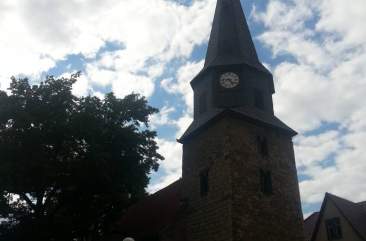Cathedral of Trier
of user Dominformation
- UNESCO World Heritage site
All information as overview
- Type
- Church
- Era
- Antiquity
- Origin
- 340
- Art Movement
- Romanesque art, Baroque
- City
- 54290 - Trier
- send E-Mail
- Phone
- +49 651 9790790
- Website
- to webpage
- Geo coordinates
- 49.756516, 6.643549
History of the Construction and the Art of the Cathedral
Trier Cathedral: 1700 years of Christian faith and construction history
According to the narration by the Rheims monk Altman of Hautvillers, the Dowager Empress Helena bequeathed a part of her house to construct a bishop’s church and had it dedicated to St. Peter. Other stories tell us that Bishop Agritius had the “House of St. Helena” converted to a church.
Archaeological examination has, in fact, verified a residence below the Cathedral from which a large painted ceiling (about 760 ft2/70 m2) has been preserved. It has been reassembled and can be viewed in the Bishop’s Museum as an example to Late Roman painting.
Starting point of Christianity north of the Alps: the first church of the Christian community
A Christian community has existed in Trier since about AD 270. The first bishops were Eucharius, Valerius, and Maternus. The first place of assembly for the congregation was probably a house church within the city walls. The Edict of Tolerance in 311 and the agreements between the Emperors Constantine and Licinius in Milan in 313 guaranteed the hitherto persecuted Christians religious freedom. Under Bishop Agritius, first mentioned in 314, a large basilica was erected between 310 and 320 over a house. Remains of this church can be seen today in the excavations under the Cathedral Information Office.
Under Bishop Maximinus (329 to 346), the first basilica was extended to the north and to the east, forming a monumental church complex with four basilicas, a baptistery, and numerous adjacent structures. The Trier church complex was thus one of the largest church complexes of the 4th century.
Beginning after AD 340, a further new structure, the “Square” was erected in the area of the Cathedral. Its outer walls still today form the core of the Cathedral.
The Medieval Cathedral
The church complex from Antiquity was destroyed in the first half of the 5th century during the chaotic period of the Germanic migrations. Bishop Nicetius (died 561) had the “Square” and parts of the north church rebuilt by “Italian masons.” The Viking invasion in 882 brought a new destruction.
After Archbishop Egbert (died 993) had begun work, only Archbishop Poppo von Babenberg (died 1047) and his successors were able to complete a renewal of the Cathedral, including the crypts and the west section: a masterwork of Salian Frankish architecture.
Dedicated in 1196, the late Romanesque choir with its crypt was built onto the east wall of the original Roman square structure; then a vaulting was built into the Cathedral. In the 13th century, the new structure of the Church of Our Lady was erected over the torn-down remains of the ancient south church; the cloister was also built at this time. Under Archbishop Balduin (died 1354), the two slender east towers were raised, but the southwest tower was not raised until 1515.
Significant elements of the medieval furnishings of the church interior have been preserved: choir walls, burial monuments, structural sculptures. The burial monuments point to the fact that the Cathedral has been the burial place of the Trier bishops since the Middle Ages.
The Baroque Cathedral
Following the end of the Thirty Years’ War, Archbishop Carl Casper von der Leyen (died 1676) began having the Cathedral remodeled. His successor, Archbishop Johann Hugo von Orsbeck (died 1711), had, among other things, the altar-like structure in the Romanesque east choir built as well as the relic chapel added onto the center back of the east choir.
The fire in the Cathedral in 1717 ultimately exacted extensive alterations to the building itself. New altars, baroque burial monuments, a wrought iron choir screen and a “swallow’s nest” organ completed the baroque remodeling of the Cathedral in the course of the 18th century.
The Cathedral Today: a Living Center of Faith
As early as the 19th century, extensive restorations were begun in the Cathedral which initially had as their goal the restoration of the church’s medieval appearance. The last great Cathedral restoration was conducted from 1960 to 1974. Not only was a comprehensive structural renovation conducted, but the interior of the Cathedral was also newly conceived. According to the liturgy constitution of the Second Vatican Council, the altar area was redesigned. On May 1, 1974, the new altar was consecrated, and the Cathedral was opened to the faithful.
Trier Cathedral: 1700 years of Christian faith and construction history
According to the narration by the Rheims monk Altman of Hautvillers, the Dowager Empress Helena bequeathed a part of her house to construct a bishop’s church and had it dedicated to St. Peter. Other stories tell us that Bishop Agritius had the “House of St. Helena” converted to a church.
Archaeological examination has, in fact, verified a residence below the Cathedral from which a large painted ceiling (about 760 ft2/70 m2) has been preserved. It has been reassembled and can be viewed in the Bishop’s Museum as an example to Late Roman painting.
Starting point of Christianity north of the Alps: the first church of the Christian community
A Christian community has existed in Trier since about AD 270. The first bishops were Eucharius, Valerius, and Maternus. The first place of assembly for the congregation was probably a house church within the city walls. The Edict of Tolerance in 311 and the agreements between the Emperors Constantine and Licinius in Milan in 313 guaranteed the hitherto persecuted Christians religious freedom. Under Bishop Agritius, first mentioned in 314, a large basilica was erected between 310 and 320 over a house. Remains of this church can be seen today in the excavations under the Cathedral Information Office.
Under Bishop Maximinus (329 to 346), the first basilica was extended to the north and to the east, forming a monumental church complex with four basilicas, a baptistery, and numerous adjacent structures. The Trier church complex was thus one of the largest church complexes of the 4th century.
Beginning after AD 340, a further new structure, the “Square” was erected in the area of the Cathedral. Its outer walls still today form the core of the Cathedral.
The Medieval Cathedral
The church complex from Antiquity was destroyed in the first half of the 5th century during the chaotic period of the Germanic migrations. Bishop Nicetius (died 561) had the “Square” and parts of the north church rebuilt by “Italian masons.” The Viking invasion in 882 brought a new destruction.
After Archbishop Egbert (died 993) had begun work, only Archbishop Poppo von Babenberg (died 1047) and his successors were able to complete a renewal of the Cathedral, including the crypts and the west section: a masterwork of Salian Frankish architecture.
Dedicated in 1196, the late Romanesque choir with its crypt was built onto the east wall of the original Roman square structure; then a vaulting was built into the Cathedral. In the 13th century, the new structure of the Church of Our Lady was erected over the torn-down remains of the ancient south church; the cloister was also built at this time. Under Archbishop Balduin (died 1354), the two slender east towers were raised, but the southwest tower was not raised until 1515.
Significant elements of the medieval furnishings of the church interior have been preserved: choir walls, burial monuments, structural sculptures. The burial monuments point to the fact that the Cathedral has been the burial place of the Trier bishops since the Middle Ages.
The Baroque Cathedral
Following the end of the Thirty Years’ War, Archbishop Carl Casper von der Leyen (died 1676) began having the Cathedral remodeled. His successor, Archbishop Johann Hugo von Orsbeck (died 1711), had, among other things, the altar-like structure in the Romanesque east choir built as well as the relic chapel added onto the center back of the east choir.
The fire in the Cathedral in 1717 ultimately exacted extensive alterations to the building itself. New altars, baroque burial monuments, a wrought iron choir screen and a “swallow’s nest” organ completed the baroque remodeling of the Cathedral in the course of the 18th century.
The Cathedral Today: a Living Center of Faith
As early as the 19th century, extensive restorations were begun in the Cathedral which initially had as their goal the restoration of the church’s medieval appearance. The last great Cathedral restoration was conducted from 1960 to 1974. Not only was a comprehensive structural renovation conducted, but the interior of the Cathedral was also newly conceived. According to the liturgy constitution of the Second Vatican Council, the altar area was redesigned. On May 1, 1974, the new altar was consecrated, and the Cathedral was opened to the faithful.
Visitor information
No information available
Landmarks in the locality of Cathedral of Trier
More landmarks Electoral Palace4.08359 Page Loads | 1 Rating
Electoral Palace4.08359 Page Loads | 1 Rating Roman Bridge Trier2.36651 Page Loads | 3 Ratings
Roman Bridge Trier2.36651 Page Loads | 3 Ratings Trier Christmas Market0.06338 Page Loads | 0 Ratings
Trier Christmas Market0.06338 Page Loads | 0 Ratings Castle and Salem Witch Museum0.011673 Page Loads | 0 Ratings
Castle and Salem Witch Museum0.011673 Page Loads | 0 Ratings
Plan your route
Liebfrauenstraße 12
54290 Trier
Germany
Start address:











So far no comments have been written about this destination. Be the first and write a comment if you have already visited the destination.
Your comment